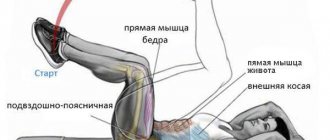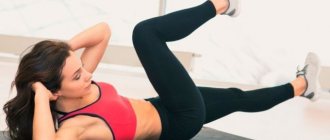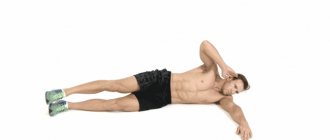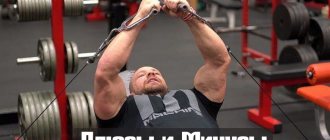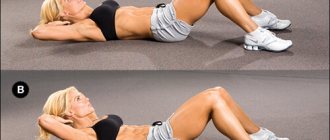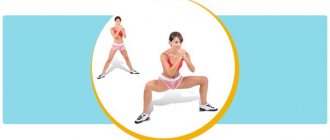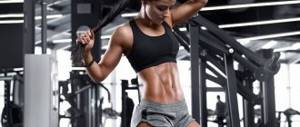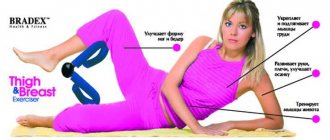Author: Timko Ilya - the ruler of the entire site and fitness trainer | more details >> Rod. 1984 Trained since 1999 Trained since 2007. Author and creator of the site tvoytrener.com. CCM in powerlifting. Champion of Russia and South Russia according to AWPC. Champion of the Krasnodar region according to IPF. 1st category in weightlifting. 2-time winner of the Krasnodar Territory championship in t/a. Author of more than 700 articles on fitness and amateur athletics. Author and co-author of 5 books.
Place in the author rating:
out of competition
(become an author) Date: 2018-09-11 Views: 49,067 Rating: 5.0
| All articles by the author >> | Medals articles >> |
Articles are loading...
Main muscles - middle delta Additional - trapezius Difficulty - medium
Crossover shoulder exercises
The crossover is a block exercise machine, the design of which allows you to perform a wide variety of exercises for all muscle groups. Thanks to its multifunctionality, the crossover has become widespread and can be found in almost any gym. This popularity, multifunctionality and ability to level out some of the technical flaws that beginners make when performing exercises with free weights forces us to touch in more detail on the topic of integrating this simulator into the training process. In this article we will talk about crossover exercises for the muscles of the shoulder girdle. Why shoulder exercises?
The importance of the shoulder girdle is difficult to overestimate! For men, the shoulders complete the silhouette of the upper body; for girls, the shoulders emphasize the fragility and femininity of the figure, while simultaneously helping to create the illusion of a “wasp waist.” For men, of course, the basis of the entire training process is high-intensity cycles, during which heavy basic exercises, “ failures ” and so on are used, but, firstly, beginners must “pump up” for some time, and, secondly, after In addition to intensive cycles, there is also always a high-volume cycle, during which the athlete is also “ pumped up ” . Can this be done with free weights? Yes, it is possible, but beginners do not have sufficiently developed technical skill for this, and more experienced athletes often experience injuries that force them to resort to tricks. But even if there are no obvious reasons, then for the sake of variety or for personal reasons you can integrate crossover shoulder exercises into your training without fear of losing its effectiveness.
Transition device
A crossover (from the English crossover, transitional or boundary device) is a multifunctional simulator with cargo blocks.
It is designed for different muscle groups. Crossovers come in different types: power, corner, for professionals, for amateurs, with an adjustable horizontal bar, etc.
The simulator has cargo traction blocks - upper and lower, their height is adjustable. Trainers believe that a crossover is a good strength training device that can replace simpler sports equipment.
Using a crossover, you can work the muscles of the back, shoulder girdle, arms, legs, chest and buttocks.
What is it needed for
It is appropriate to purchase a crossover only for gyms. It is unlikely to be suitable for home (it is quite bulky).
Of course, if your living space allows it, then you can buy this exercise machine. In any case, it is a useful unit for muscles.
Men like to use the crossover to give their muscles a clear definition. It is also held in high esteem by women: the lower block of the simulator works the muscles of the legs and buttocks.
Briefly about the anatomy of the shoulder girdle
As you may have noticed, the shoulder girdle is formed not only by the deltoid muscles; there are also a lot of other superficial, postural, large and small muscles attached to the humerus. In this regard, the athlete should think not only about how to load the target deltoids, but also about how to exclude more massive muscle groups from work. Why? Because the body always follows the path of least resistance! If stronger muscles can work instead of the shoulders, then the body will innervate them. This is simply the law of conservation of energy. This means you understand that you are training for a specific purpose, and the body is performing a physical task, trying to minimize energy costs. This must be understood and remembered!
The topic of the anatomy of the shoulder girdle is, in general, very interesting, but we touch on it in this article only to the extent necessary to form a correct idea about shoulder training for an inexperienced reader. Therefore, before “throwing slippers,” accept the fact that not everyone is as erudite as you are and may not know some banal things, however, their area of knowledge may be wider in some other area. So what's important? The important thing is that the shoulder joint is located in the spine of the scapula and is limited above by the acromion. This means that the deltoid muscles perform adjacent functions to the muscles that move the scapula, and these are, first of all, the latissimus dorsi muscles, and that the shoulder joint is very mobile.
You see that the shoulder can be moved literally in any direction, and the radius of its movement is limited only at the top by the acromion. Which deltoid you use to lift the humerus up depends on which deltoid is located above the axis of the shoulder joint. You can verify this yourself by raising your hand forward, to the side, or pulling it back. The most obvious way to see this is by raising your arm forward. If you raise your arm forward with your elbow facing the floor, you will feel the innervation in the anterior deltoid bundle, and if your elbow looks to the side, you will feel the innervation of the middle deltoid bundle.
On the subject: How to properly do a dumbbell shoulder press
You can raise your arm up both by bringing the scapula up and by rotating the humerus. This movement can be easily caught by fixating on it, if at this time there is no additional weight in your hands. So, if you perform any exercise on the shoulders, it doesn’t matter, in a crossover, with dumbbells, a barbell or a kettlebell, displacing the shoulder blade, then the load will go to the latissimus dorsi muscles, and the exercise will lose all meaning. It is necessary to perform exercises on the shoulders with a fixed shoulder blade, in such an amplitude that the movement, for the most part, can be performed due to the movement of the humerus.
Content
- 1 Muscles working in the crossover
- 2 How to make a crossover 2.1 Typical mistakes when working in a crossover
Muscles working in the crossover
Video: performing a crossover (exercise)
Crossovers refer to auxiliary exercises for developing the chest muscles, or more precisely, their inner and lower parts. They are performed on a special simulator - blocks. Crossovers are not recommended to be used as completely independent exercises in the “chest” complex, but in combination with exercises such as bench press, incline barbell press, dumbbell flyes, etc. In general, crossovers are used at the stage of “polishing” muscle groups. They are not recommended for beginners who are at the initial stage of gaining muscle mass.
The undeniable advantage of crossovers is their ability to stretch the chest muscles well. This cannot be achieved with a bench press, since the bar of the bar does not allow the chest to stretch as much as possible.
The crossover trainer, like the Smith machine, was invented by the American athlete Jack Lalenne. However, none of these simulators received his name.
Basic crossover shoulder exercises
Sources:
Adolfo Cassan "Illustrated Atlas of Human Anatomy"
Frederic Delavier "Anatomy of strength exercises"
Source
Raising your arms in front of you from the lower block while sitting on an inclined bench
Targeted muscles:
- anterior head of delta;
- trapezoids.
Execution order:
- set the bench to an inclination in the range of 45°-60°;
- attach a short straight rod or cable to the block;
- take your starting position sitting on a bench and grab the barbell (cable handles), the grip width can vary from narrow to wide;
- at the beginning of each repetition, the arms should be fully straightened and a few centimeters above the hips;
- Moving only your shoulders, slowly raise your arms above your head and hold in this position for 1-2 seconds;
- slowly return to the starting position.
What does the exercise do? This angle provides maximum tension throughout the entire range of motion, which is great for stimulating the growth of the anterior shoulder muscles.
Abduction of one arm to the side while lying on a bench
Target muscles : lateral head of deltoid.
Execution order:
- install the bench so that its inclination angle is from 35° to 45°;
- grab the D-shaped handle and take a starting position on the bench, lying on your side (make sure that the position is comfortable for your legs and non-working arm);
- begin to straighten your working arm (PP), holding it a few centimeters above the surface of the thigh;
- slowly raise the PP, keeping it in line with the body, until the deltoid muscle contracts to its maximum;
- hold in this position for 1-2 seconds;
- slowly return to the starting position.
The result of the exercise . At the specified angle of inclination, new muscle groups that are not involved in the usual version of the exercise are involved in a single muscle impulse. In addition, the increased load created by the cable, both at the beginning and end of each repetition, will force the side delts to work harder than they are accustomed to.
Execution technique
Often in isolated exercises, technique plays a more significant role than the weight itself. Crossover is no exception. Our task is not to load the muscle to the maximum (there are basic exercises for this), but to make it work so that it grows in the way we need. Well, or in the case of using exercises for finishing, we are working with an already tired muscle, so heavy weights are also irrelevant.
Let's look at the crossover in its classic form, leaving the variations for last.
- Set the required weight on the machine. It should be the same on the right and left. Use a load that will allow you to perform movements completely under control, without jerking.
- Stand straight between the posts, bend slightly forward with your back straight. Place your feet shoulder-width apart, knees slightly bent. Some athletes put one leg forward for a more stable body position when bending over. This approach has its place, however, when using it, it is necessary to alternate the position of the legs from approach to approach. This will avoid asymmetry of the load on the right and left sides.
- Raise your hands and grab the handles of the blocks so that you feel a stretch in your pectoral muscles. The elbows should be bent (this rule remains the same throughout the entire movement), the shoulder blades should be pressed tightly against the back. Lock yourself in the starting position.
- As you exhale, without bending your back or changing the angle of your elbows, slowly and under control bring your arms together below you in front of you. The insides of your wrists should be facing each other. Concentrate on maximizing the strength of your pectoral muscles. At the bottom of the exercise, hold for 1-2 seconds. You can even slightly move one hand behind the other (alternately) to increase the amplitude.
- As you inhale, raise your arms again to the starting position.
The classic version of the crossover emphasizes the load on the lower chest.
When performing the exercise, do not allow your elbows to straighten. The angle of about 10 degrees is maintained all the time. With the correct technique, the trajectory of the brushes' movement resembles a semicircle. The back should remain straight at all times. Shoulders should be straightened.
It is also important to control muscle effort and not allow yourself to work with your arms. We train specifically the pectorals, remember this. Avoid jerking - the movement is carried out evenly, the muscles do not relax for a second.
Wide-grip lat pull-down while sitting on an incline bench
Targeted muscles:
- latissimus dorsi muscles;
- rhomboid back muscles;
- teres major;
- middle part of the trapezius muscle.
Procedure for performing the exercise:
- Set the incline bench at an angle of approximately 45°;
- place the bench inside the machine,
- take a wide handle;
- take the starting position - grab the handle of the block so that your hands are wider than your shoulders, sit face down on the bench, legs back;
- pull the handle down until the bar touches your chest;
- at the bottom point of the movement, you need to slightly bend your back, move your elbows back and bring your shoulder blades together as much as possible;
- hold in this position for 1-2 seconds;
- return to the starting position.
On topic: Pump up your shoulders with one barbell
What does the exercise do? Due to the unique angle of inclination, the entire back muscles contract very strongly, which helps to better feel the muscle connection. In addition, with this use of an incline bench there is no opportunity to impart momentum to the movement that increases fiber activation in the target muscles.
Crunches on blocks
The best isolation exercise for building powerful abdominal muscles that you should definitely include in your program. Execution technique.
The best abdominal exercise
The most important criteria for choosing the most effective abdominal exercise is both the involvement of the maximum number of fibers of the abdominal muscles, and the exclusion of secondary muscles from the work - primarily the muscles of the neck, back and front of the thighs.
Incorrect technique for performing hanging leg raises will shift a significant amount of load from the abdominal muscles to the muscles of the lower back and legs, and the inability to feel your abs in classic crunches activates the neck muscles, provoking the appearance of chronic pain.
Which abdominal exercise is better - crunches or hanging leg raises? How to pump up your abs effectively - the results of a scientific study.
Avoid challenging exercises
One of the first rules of abdominal training is to be able to feel the abdominal muscles and maintain them in a tense state while performing exercises. At the same time, technically complex exercises and too much additional weight significantly complicate the task.
Trying to start training weak abdominal muscles with the aforementioned hanging leg raises or roller crunches is doomed to failure. Untrained abdominal muscles will not be physically ready for such loads, forcing the body to use secondary muscles.
Crunches on the upper blocks
Performing crunches on the upper blocks allows you to both learn to feel your abs in work and limit the involvement of secondary muscles. It is especially important to remove unnecessary stress from the cervical region - a typical cause of pain and crunches in the neck among novice athletes.
An additional advantage will be that variations of crunches on blocks can include elements of the “Vacuum in the Abdomen” exercise - one of the few that trains the internal transverse abdominal muscles and creates not just strong, but toned and elastic abs.
Ab crunches on blocks: correct technique
The key parameter of cable crunches is the maximum range of motion. You should not be hampered by a too short piece of rope or a pulley weight limiter. The weight in the exercise should be moderate—you should never lift yourself off the floor.
1. Grasp the rope, step back a few steps and kneel down. Bend your elbows at a right angle. Lean forward, arching your back slightly. Shift your body weight onto your knees and toes, as if hanging from your arms (but without straining them). Feel the tension in your abs.
2. As you exhale, using your abdominal muscles, slowly twist until your elbows touch the floor or knees, constantly feeling the work of your abs. At the lowest point, the back should be slightly rounded. After a short pause while inhaling, slowly return to the starting position.
Complicated variation
To engage the oblique abdominal muscles, do not bend vertically downwards, but turn to the right or left side alternately. Point your right elbow towards your left knee, and vice versa. In this case, your free hand can be held either behind your back or on your knee.
Common mistakes
It is important to ensure that when performing crunches on blocks, the elbows do not extend and the position of the shoulders does not change, otherwise the load will fall on the arms and latissimus dorsi muscles, turning the exercise into something like a pullover. The movement should be carried out precisely by the abdominal muscles.
The pelvis should remain motionless during movement. The movement in the exercise starts from the lower back, as with a regular twist. If you begin to shift your pelvis and move it forward, the bulk of the work will shift from the abs to the hip flexors.
How many repetitions should I do?
To increase abdominal muscle strength and achieve massive abs, perform 3 sets of 6-10 repetitions. To work on the relief of your abdominal muscles, perform 3-4 sets of crunches on blocks with a high number of repetitions (from 12 to 25) and a lower working weight.
The exercise can be performed in every workout; it is important to ensure that its analogues (for example, reverse crunches) are not included in the program. A good addition to crunches on the upper blocks would be a plank or the aforementioned vacuum in the abdomen.
***
Crunches are one of the few isolation exercises for the abdominal muscles. A simple technique will allow even beginners to perform this exercise correctly, which guarantees quick results in the form of creating a powerful stomach and pumped up abs.
internal abdominal muscles, abdominal muscles, crunches, block exercises, abdominal exercises
Source: fitseven.ru
Close-grip lat pull-down while standing on an incline bench
Target muscles : latissimus dorsi (focus on the lower part).
Execution order:
- adjust the angle of the bench in the range from 30° to 70° (change the set position before each approach or new workout);
- attach a V-shaped handle to the cable (if possible, try to find one that is wider than the bench at the top);
- Grasp the handle with your palms and carefully return back to the base of the bench;
- While continuing to stand, to stabilize the position, tilt your chest towards the top of the bench, place your legs behind the line of your back;
- begin to pull the handle towards the lower abdomen, slightly arching your back, keeping your elbows close to your body and your chest raised high;
- control the traction force so that the shoulder blades are brought together as much as possible.
Why do this? Performing the exercise with the bench at this angle allows you to pump up the lower part of the latissimus muscles where they come into contact with the spine. In addition, the incline bench forces you to use a narrow grip, which stimulates the growth of target muscles in thickness.
What to remember
The crossover is an almost universal exercise machine (for men and women), with which you can work out most of the muscles in our body.
This simulator does not affect the growth of muscle mass. On the contrary, it only forms the muscle.
Using a crossover, you can perform various variations of exercises for a particular muscle group.
It is important to perform the exercises efficiently, having first carefully studied the information about them or take the advice of a trainer.
This is where I end. See you again on the expanses of my blog!
Raising arms to the sides in a sitting crossover
Target muscles:
- rhomboid muscles;
- middle part of the trapezius muscle;
- posterior head of the delta.
How to do the exercise:
- install a straight bench in the center of the crossover;
- Grab the D-shaped handles and sit so that your torso is about 30 cm in front of the blocks;
- working with your elbows, pull the handles to the sides until you feel your shoulder blades touch;
- to make the contraction even more intense, try to move your elbows slightly back behind your body and down;
- hold this position for 1-2 seconds, focusing on feeling the tension in each muscle in your inner back.
Purpose of the exercise . The movements will pump up and isolate the rhomboids and mid-trapezius. For other muscles involved in movement, the exercise allows for deep work in any position of the back.
Exercise crossovers
Good day to all. Today we’ll look at an interesting exercise called crossovers.
The crossover exercise targets the lower and inner parts of the pectoral muscles.
The exercise is isolating and targets the chest muscles.
Unlike other exercises for developing chest muscles, such as the bench press, the triceps and deltoids are practically not involved in the movement.
This allows targeted and isolated action on the pectoral muscles. It will not be possible to build up a huge mass of pectoral muscles by performing crossovers, but it is quite possible to give shape and relief.
To perform crossovers, we need a block simulator. Most gyms have it. Of course, you won’t be able to train at home. Look at the photo to see what the simulator looks like.
How to do crossovers exercise
So, we get into the simulator between the blocks. To provide greater stability, you can place one leg slightly forward. We grasp the handles of the simulator with our hands. We bend the torso slightly forward. We bend our arms slightly at the elbow joints, palms facing each other. Hands are spread to the sides. This is our starting position.
We take a deep breath and, tensing the chest muscles, bring our arms in front of us and slightly down, approximately at the level of the lower part of the pectoral muscles. After touching your hands, strain your chest muscles as much as possible, exhale, then slowly return your hands to their original position. In the starting position, the pectoral muscles are stretched to their maximum. We do the planned number of repetitions.
You can see the correct exercise technique here.
Throughout the movement you should feel the pectoral muscles working. In principle, in terms of execution technique and effect, this movement is similar to lying dumbbell flyes.
Attention!
So you can use it at home. However, in terms of the degree of impact on the muscles, it is significantly superior to dumbbell flyes, i.e.
at the moment of contact of the hands, maximum tension is maintained in the chest muscles, in contrast to lying flyes.
There are various options for crossovers: standing, sitting, reclining, kneeling. This allows you to work the chest muscles from different angles and intensify your approaches. In addition, some craftsmen manage to work on each hand separately. In my opinion, this is a perversion. I do it classically - standing.
Keep your body still throughout the entire approach. If you have to help yourself by moving your torso (cheating), you should reduce the working weight. Also, do not bend your arms at the elbow joints, as the movement turns into something like a press and some of the load is removed from the pectoral muscles.
At the same time, do not put them off until the very end of the workout, when you no longer have the strength to intensively work on the pectoral muscles. The ideal option is somewhere in the middle of the workout.
3-4 sets of 8-12 repetitions each are enough.
Include crossover exercises in your training program and you will build the chest of your dreams!
In the near future, I plan to write an excellent drying technique, thanks to which you will get rid of excess fat and not lose muscle tissue. So don't forget to subscribe to blog updates and receive the latest articles in your email.
PS. By the way, I advise you to familiarize yourself with the nuances of the technique of basic exercises in video format.
Bringing your arms to your chest while lying on an incline bench
Targeted object : clavicular head of the pectoral muscle.
How to do the exercise:
- set the bench at an incline of approximately 75°;
- place it centrally inside the simulator;
- adjust the cables so that when you grip the handles, your shoulders are at an angle of about 70° in relation to your torso;
- from a standing position, lie with your back on the bench;
- clasp the handles with your palms;
- Having slightly bent your elbows, begin to bring your arms across your body and slightly upward, so that when they meet, they are approximately at the level of your nose;
- hold in this position for 1-2 seconds, squeezing and straining your pectoral muscles;
- gradually relaxing the muscles, slowly return to the starting position.
Results . The exercise is a kind of hybrid of the lower row in the crossover and the pinch of the arms in the butterfly machine. However, because it creates a unique plane in which the movement occurs, it stimulates the muscles of the upper chest (just below the collarbone) well.
Fitness exercise crossover
The crossover exercise has recently become popular in gyms, because lack of funds is the main problem that owners of such complexes have to face.
The only way out of this situation is to use various alternative exercises that will help to better develop the deltoid muscles, define them and make them more dry.
But no matter how hard we try, the crossover is the only exercise machine that allows you to enlarge the upper biceps and also define the deltoid muscles.
Deltoid muscles.
The technique for performing the crossover exercise is quite simple. But we need to know what exactly we want from the exercise. If we need to pump up the deltoid muscles, then the exercise should be performed in the following style:
Important!
Moreover, it is important to understand that when you perform a crossover exercise, heavy weights are very, very unhelpful. Using small weights, proper exercise technique and the correct range of motion will allow beginning athletes to avoid injury.
And an injury at the initial stage of your career can even affect you in sports for the rest of your life. By the way, an excellent option for pumping up the deltoid muscles will allow you to implement a body solid crossover.
Its price is not that high, and the quality is one of the best in Europe.
The next stage is pumping the pectoral muscles on a crossover.
Here things are a little different. The fact is that the pectoral muscles develop exclusively from the bench press of the barbell, as well as from push-ups on the uneven bars. Of course, this also includes the option of push-ups.
But we will do purely exercises in the gym. Who goes to the gym to do push-ups? Therefore, carefully watch the video and remember the technique of performing the exercise.
There are a lot of variations in execution on a crossover, but it’s not a fact that the technique is correct everywhere:
It is also still possible to perform biceps exercises using a crossover, but this is more related to drying out the muscles, as well as isolating individual bundles of fibers on the body. For a beginner athlete, such exercises are a complete waste of time + also a lot of fatigue after training. Don't do nonsense and don't waste your energy!
Biceps curl from the upper block in the simulator
Target muscles:
Procedure for performing the exercise:
- install a short straight barbell (straight handle) on the vertical block of the simulator;
- sit on a bench and put your feet under the bolsters;
- grab the handle with a wide, straight grip (make sure your arms remain straight before starting each rep);
- lean your body back slightly as you lower the barbell down and back behind your head, but do not use your body momentum;
- make sure that the biceps are strongly bent at the bottom of the movement;
- hold for 1-2 seconds;
- slowly return to the starting position.
Why do this? Because this movement raises the elbows above eye level, the biceps becomes a less powerful forearm flexor. This engages the brachialis underneath the biceps, which in turn stimulates the hypertrophy of this muscle. By increasing the mass of the shoulder girdle, the biceps will be “pushed” upward, creating the illusion of a higher peak when the arm is curled.
Crunches on the upper block for the abs (exercise “Prayer”)
The traditional method of working out the abdominal muscles is various types of crunches. One of the variations of this exercise includes crunches on the upper block or the “prayer” exercise. This exercise allows you to most effectively pump up your abdominal muscles, as well as avoid unnecessary stress on the lumbar region.
Crunching on the upper block is one of the optimal exercises for building strength and definition of the abdominal muscles. Unlike classic crunches while lying on the floor, when practicing on a block, you can achieve a maximum range of motion to contract the abdominal muscles. This exercise is very popular among professional bodybuilders.
Benefits of the exercise “prayer” on the upper block:
- increase in the strength qualities of the abdominal muscles;
- toned stomach and abdominal tone;
- training of the entire core muscle group (stabilizer muscles);
- can be performed in case of previous injuries or problems with the spine.
Muscle load
When performing crunches on a block, absolutely all abdominal muscles work in a complex manner. This is the main advantage of this exercise.
The key advantage of this exercise is that it uses the entire array of abdominal muscles.
Crunches on the upper block include:
- rectus abdominis muscle;
- external and internal oblique abdominal muscles;
- transverse abdominal muscles.
The obvious advantage of crunches on the upper block is that it allows you to remove unnecessary unnecessary stress on the lumbar region.
For maximum benefit, efficiency, and also to reduce the risk of injury during training, it is necessary to strictly adhere to the technique of performing the movement, which will be discussed below.
Technique for performing crunches on a block
The exercise is performed using a simulator with an upper (vertical) block. As a rule, this simulator is used to perform exercises to work the muscles of the back or arms.
First of all, you need to adjust the upper block and take the starting position:
- Attach a rope handle for traction to the cable of the upper block. Of course, in the absence of a rope handle, you can use a straight or V-shaped handle, but they will be less convenient for twisting.
- Place moderate weights on the machine, which will allow you to perform the exercise with the correct technique.
- Approach the block with your face and grab the handle of the machine with a pronated (straight) grip. However, when using a straight handle, it is more convenient to hold it with a reverse grip.
- Move 1-1.5 meters back, but no further. Slowly lower yourself to your knees, overcoming the tension of the weight of the weight, bend your arms at the elbows.
- Bend your torso forward, slightly rounding your back. Pull the handle of the exercise machine towards your forehead. Keep your pelvis still, your back slightly rounded, and your abdominal muscles relaxed throughout the entire approach.
- As you exhale, gently twist your torso forward, lowering your head almost to the floor. The elbows should touch the knees. Round your upper body as much as possible, feeling the contraction of your abdominal muscles.
- At the lowest point of the amplitude, hold your position for 1-2 seconds.
- As you inhale, slowly return to the starting position. Do not straighten your back completely.
Do 3-4 sets of 12-20 reps. By adjusting the degree of load, you can shift the emphasis to the abdominal muscles.
Common Mistakes
The main mistake made by novice athletes when performing the “prayer” exercise on the upper block is simply bending the torso instead. Bending mainly loads the back muscles, while the abdominal muscles practically do not work.
- During the exercise, you should try to round the upper back, bringing it towards the pelvis. At the same time, do not allow the back to arch, especially in the lumbar region. If you do the exercise with a straight back, the entire load from the press will be transferred to the back muscles.
- Do not try to pull the weight with your hands; they only perform the function of holding the handle of the exercise machine in a fixed position in the area of your forehead. Otherwise, instead of the abdominal muscles, the exercise will include the arm muscles (triceps) and the latissimus dorsi muscles. Therefore, keep your shoulder girdle and arms still and feel the contraction of your abdominal muscles, which will allow you to achieve effective results.
- Do not bend too low to the floor, touching its surface with your forehead. Inclining too much will not necessarily lead to increased efficiency; the main goal is to shift the load to the target muscles, namely the abdominal muscles.
- Maintain tension in your abdominal muscles throughout the movement.
- Do not jerk downwards. Leave the body within the given trajectory of movement; swaying the body from side to side will lead to a violation of the correct technique.
- Do not use excessive weights on the machine. Excessively heavy weights can lead to an increased risk of injuries and sprains. Additionally, too much weight will pull you up and prevent you from doing the exercise correctly.
Like other abdominal exercises, crunches ("prayer") are recommended to be performed at the end of your workout.
For the most dramatic results, the best ab workout option is to combine this exercise with other abdominal exercises, such as traditional crunches or hanging leg raises.
Crunches on the upper block can be performed by both beginners and more experienced athletes. Systematic implementation of this exercise can put a targeted load on the abdominal muscles, which will allow you to achieve a toned stomach, reduce your waist and improve your relief.
Video: Twisting on the upper block on the press:
Share: Source: power-body.ru
This is interesting: Power press: bridge, technique, notes, practical recommendations and diagram of performing power press with a bridge
Triceps extensions lying on an incline bench
Target muscles : triceps.
Procedure for performing the exercise:
- set the bench to an inclination angle of approximately 45°;
- install the bench in the crossover so that the distance between its end part and the center of the machine is 60-90 cm (when you lean back on the bench, your head should be closer to the weight than your legs);
- Attach a horizontal handle or rope handle to the cable, which must be interchanged before performing each new approach or at the beginning of the next workout;
- sit down and lean back on the bench, ask the assistant to give you the handle;
- elbows spread out to the sides should be in line with the torso (they must be held in this position throughout the entire set);
- Instead of lowering the handle straight down, you will have to perform a movement that combines elements of extension and thrust at the same time;
- continue the movement until the muscles contract completely and hold this position for 1 second;
- slowly return to the starting position.
On the subject: The deltoid muscle abducts the shoulder to the side
Result : the exercise, being a combination of triceps rows and extensions, combines the best of them in terms of enhanced impact on the triceps.
Bent-over arm extension on a lower block
Target muscles : triceps.
Procedure for performing the exercise:
- grab the end of the cable of the upper block (preferably the tip);
- bend towards the floor at a right angle;
- bend your legs slightly, place the elbow of your non-working arm on your knee;
- hold the cable so that the movement can be performed with a hammer grip;
- starting with the triceps, at full stretch, slowly straighten your elbow until your arm is straightened and the triceps are fully contracted;
- hold in this position for 1-2 seconds;
- return to the starting position.
Why do this? The unique positioning of the arm and torso makes this exercise similar to concentrated biceps hammer curls. When the movement is performed absolutely correctly, the triceps muscles contract extremely strongly, which ensures rapid mass growth.
Bicep curls while sitting on an incline bench
Target muscles:
Procedure for performing the exercise:
- give the bench an inclination angle of approximately 45° and place it in front of the upper crossover block;
- Attach a horizontal handle to the cable (or a rope handle if you want to perform hammer bends);
- grab the handle and lie with your back on the bench;
- at the beginning of each repetition, the arms should be straight and directed upward towards the block;
- Without using your shoulders or forearms, slowly pull the cable towards your forehead, continuing this movement until it touches;
- Flexing your biceps as hard as possible, hold the peak contraction for 1-2 seconds;
- slowly return to the starting position.
Why do you need to do the exercise? As your arms are extended in front of you, the traction will act on the brachialis, stimulating its growth. The increase in biceps directly depends on this factor. Thus, the brachialis plays the role of the “great mass builder.” In addition, strict adherence to the exercise technique provides a powerful, unparalleled contraction of the biceps, which leads to a rapid increase in its volume.
Crossover squats
Target muscles:
Performing the exercise:
- grab the horizontal handle or cable attached to the lower block and step back;
- when the weights, having risen, create tension in the cable, keeping your arms straight, squat down, as if you were sitting on a low bench behind your buttocks;
- when your thighs are parallel to the floor (or just below this point), hold in this position for 1 second;
- Stressing your quadriceps and glutes as much as possible, slowly return to the starting position.
Why do this? The exercise is an excellent alternative to squats in various machines and basic squats. Its peculiarity is that the load on the muscles when squatting is distributed from the bottom up, and not from the weight on the upper back.
What muscles work during exercise?
If you do everything correctly, then almost the entire load falls on the pectoral muscles. Some static tension is present in the biceps, triceps and front delts, but this should not interfere with your ability to concentrate on working your chest. If you feel that your shoulders and triceps are no less tired than your chest, then the working weight is too heavy.
The abdominal muscles and buttocks act as stabilizers, thanks to them we take the correct position.
